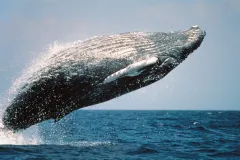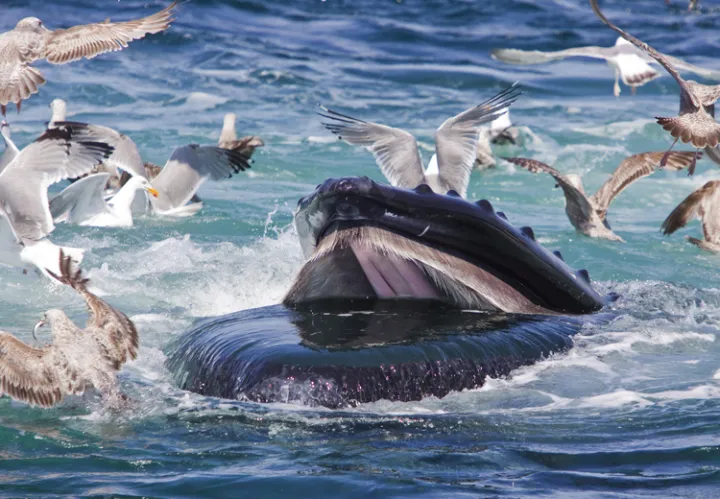Bacteria on Whale Skin Tell a Tale of Health and Sickness

Whales swimming in the ocean are never really alone. Even if one swims by itself with no other whales for miles around, it still has company—the tiny microbes that live on its skin. For a long time, these microbes went unnoticed or ignored. What scientists knew about skin microbes on whales was limited to studies on stranded or deceased animals, and virtually nothing was known about the microbes residing on healthy, free-ranging whales. But as links are now emerging between the microbiology of human skin and health, immunity and skin disorders, I realized that it could also be possible to learn about the health of marine mammals by studying the microbes on their skin.
We first examined the skin bacteria of North Pacific humpback whales (Megaptera novaeangliae) breeding in Hawaiian waters. Humpbacks are migratory animals that feed up north in the Arctic and make one of the longest migrations of any mammal to lower latitudes for birthing and mating. How on earth do you take a sample of their skin bacteria? Lucky for me, my marine mammal colleagues were already permitted for and skilled at collecting skin from these animals for a population genetics project. I sub-sampled skin from small biopsies already being taken for their project, and also skimmed floating skin off the ocean's surface after whales leapt out of the water, a behavior known as breaching. Back at the laboratory, we analyzed the skin using genetic techniques focused on bacteria. We found, to our surprise, similarities in the types of bacteria hosted by the various North Pacific humpback whales we sampled. We also observed some differences in the bacterial communities on the skin of whales that were mildly health-compromised, like those entangled in fishing gear, compared to samples from healthy whales. This implication for health was very preliminary, but still pretty exciting.
We realized that we needed to see whether the same bacterial species occur on the skin on other populations of humpbacks, or if the specific ocean environment that the whales inhabited in Hawaiian waters biased the composition of the skin-bacteria. In order to tackle this global question, I teamed up with marine mammal scientists from many institutions to embark on a study of different populations of humpback whales. Strikingly, skin examined from 56 individual whales from populations in the North Atlantic, North Pacific and South Pacific oceans all harbored, and were generally dominated by, the same two groups of bacteria. Regardless of population, age or sex, all animals had bacteria on their skins belonging to the Flavobacteria (Tenacibaculum) and the Gammaproteobacteria (Psychrobacter). These groups are marine bacteria previously found in association with marine animals, and but the types on the humpback whales’ skin hadn't been seen together before.
The discovery of this core bacterial community on the skin of healthy humpbacks allowed us to follow up on the other important question from our first results: if and how the bacteria residing on a whale's skin may reflect its overall health. In collaboration with scientists that respond to whales in crises, we compared the skin bacteria of healthy whales to those exhibiting potentially health-compromised conditions, including animals entangled in fishing gear, or those recently beach-stranded or deceased. The abnormal whales hosted fewer of the healthy core bacteria (Tenacibaculum and Psychrobater), and we also found the potential disease-causing bacteria. While only based on a few samples, this research does suggest that the skin-bacteria may be connected to humpback health.
Before we can begin using skin-bacteria to diagnose whale health, scientists need to understand better how these bacteria are interacting with the whales and their potential role in keeping the whales healthy. For example, it is possible that Tenacibaculum and Psychrobacter are prohibiting the colonization of larger fouling organisms that might slow the whales' swimming speeds, like barnacles and phytoplankton, or even disease-causing bacteria. Bacteria can secrete antibiotics and other compounds that are detrimental to their fellow bacteria as well as other organisms, and this might be an important aspect of this relationship. Though we still need to learn more, the implications of this research are exciting and suggest that monitoring the skin-associated bacteria may provide a useful way to monitor the health of threatened and endangered marine mammals. This is important because it is a lot easier to sample the skin of whales than it is to bring a whale to the vet!
Editor's note: You can read her paper at PLOS ONE. Dr. Apprill wants to acknowledge the many other scientists involved in the work: her PhD advisor Michael Rappé (University of Hawaii, UH); Marc Lammers (Oceanwide Science Institute), Edward Lyman (Hawaiian Islands Humpback Whale National Marine Sanctuary, HIHWNMS), T. Aran Mooney (formerly UH, presently at Woods Hole Oceanographic Institution, WHOI) and Alison Stimpert (formerly UH, presently at Moss Landings Marine Laboratory), who let her use their whale skin samples and helped her with collecting additional samples; her post-doc advisorTracy Mincer (Woods Hole Oceanographic Institution) and marine mammal scientists Jooke Robbins (Provincetown Center for Coastal Studies), Adam Pack (University of Hawaii, Hilo) and David Mattila (HIHWNMS), with whom she conducted the study of 56 humpback whales; and Michael Moore (WHOI) and Katie Moore and Misty Niemeyer (International Federation for Animal Welfare) who helped with the whales in crises.


